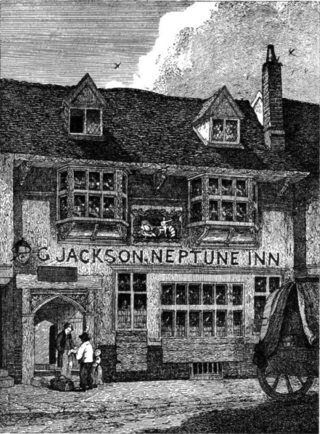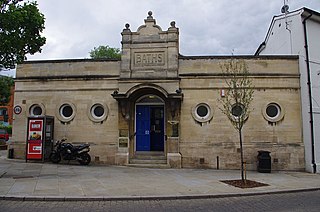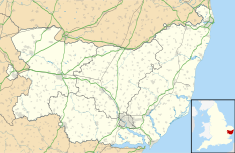
Christchurch Mansion is a substantial Tudor brick mansion house built in Ipswich, Suffolk by Edmund Withypoll around 1548–50. The Grade I listed building is located within Christchurch Park and sits by the southern gates close to the town centre of Ipswich. The mansion belonged to various noble families throughout its history but was purchased by the Ipswich Borough Council in 1884. Since 1885, the building has been used as a museum and is today run by the municipally run Colchester and Ipswich Museums Service (CIMS)organisation. The museum's rooms are preserved as past inhabitants would have known them, complete with original items such as furniture, fine clothing and children's toys. The museum also holds a collection of paintings by renowned local artists including John Constable and Thomas Gainsborough. The Mansion is free to enter and booking is not required.

Stanley Dock is a dock on the River Mersey, England, and part of the Port of Liverpool. It is situated in the Vauxhall area of Liverpool and is part of the northern dock system. The dock is connected to the Leeds and Liverpool Canal to the east and Collingwood Dock to the west.

The Cliff Brewery is a Grade II listed former brewery in Ipswich, England. The building dates to 1896 and was designed by William Bradford.

Chester Square is an elongated residential garden square in London's Belgravia district. It was developed by the Grosvenor family, as were the nearby Belgrave and Eaton Square. The square is named after the city of Chester, the city nearest the Grosvenors' ancestral home of Eaton Hall.
Richard Shackleton Pope was a British architect working mainly in Bristol. His father was a clerk of works for Sir Robert Smirke, and Pope succeeded him, also working for C.R. Cockerell. He moved to Bristol to work on one of Cockerell's projects and decided to settle in the city, where he became District Surveyor from 1831 to 1874, with considerable influence over building works.

The architecture of Manchester demonstrates a rich variety of architectural styles. The city is a product of the Industrial Revolution and is known as the first modern, industrial city. Manchester is noted for its warehouses, railway viaducts, cotton mills and canals – remnants of its past when the city produced and traded goods. Manchester has minimal Georgian or medieval architecture to speak of and consequently has a vast array of 19th and early 20th-century architecture styles; examples include Palazzo, Neo-Gothic, Venetian Gothic, Edwardian baroque, Art Nouveau, Art Deco and the Neo-Classical.

Fore Street in Chard, Somerset, England was built in the late 16th and early 17th century, following a fire which destroyed much of the town in 1577.

The Ipswich Waterfront is a cultural and historically significant area surrounding the marina in the town of Ipswich, Suffolk, England. The modern dock was constructed in 1842 and the area was a functioning dock up until the 1970s. At the time of completion, the dock was known as 'the biggest and most important enclosed dock in the kingdom'. Although the dock as it stands was constructed in 1842, the area was used for trade as far back as the 7th century. The decline of industry in the town resulted in the area being transformed into a trendy area of Ipswich, the waterfront is now characterised by its marina, known as Neptune Marina, as well as its mix of classical and postmodern architecture which includes multiple high-rise apartment buildings, restaurants, bars and cafés. The waterfront is also home to the main campus of the region's university, the University of Suffolk.
The Cobbold family is a prominent family that flourished in Ipswich since the eighteenth century. They first became prominent for their involvement in the brewing industry, but subsequently became involved in other areas of trade, banking politics and the arts. They have also been prominent promoters of Ipswich Town Football Club.

Liverpool is a city and port in Merseyside, England, which contains many listed buildings. A listed building is a structure designated by English Heritage of being of architectural and/or of historical importance and, as such, is included in the National Heritage List for England. There are three grades of listing, according to the degree of importance of the structure. Grade I includes those buildings that are of "exceptional interest, sometimes considered to be internationally important"; the buildings in Grade II* are "particularly important buildings of more than special interest"; and those in Grade II are "nationally important and of special interest". Very few buildings are included in Grade I — only 2.5% of the total. Grade II* buildings represent 5.5% of the total, while the great majority, 92%, are included in Grade II.

St Mary-at-the-Quay Church is a former Anglican church in Ipswich, Suffolk, England. The medieval building is under the care of the Churches Conservation Trust. and since September 2021 it has been used by River Church to implement an approach to evangelicism developed by Holy Trinity Brompton as part of the network of HTB church plants. The church originally served the thriving industry around the docks area of the town and those that worked there. After closing for regular worship in the 1950s the church was transferred to the CCT in 1973 and underwent a major restoration programme completing in 2016.
There are many Grade II listed buildings in the city of Manchester, Greater Manchester, England. The majority of Manchester's listed buildings date from the Victorian (1837–1901) and Edwardian (1901–1911) eras, most as a consequence of the Industrial Revolution. In England and Wales, the authority for listing is granted by the Planning Act 1990 and is administered by English Heritage, an agency of the Department for Culture, Media and Sport. There are three categories of listing – Grade I, Grade II* and Grade II.

Town Quay is a quay and pier in Southampton, England.
Mousehole is a village and fishing harbour in the civil parish of Penzance, Cornwall, England, UK.

Neptune Inn is an historic public house located in Fore Street, Ipswich, Suffolk, England. The building was originally built around 1490 and is grade II* listed.

Fore Street, Ipswich has been a prominent street in Ipswich, Suffolk since the fifteenth century.

The Steam Packet Inn was a public house located at 2/4 Duke Street, Ipswich, Suffolk, England. It closed on 18 September 1960. The building had been owned by Cobbold Brewery but after closure it was sold to Eastern Counties Farmers (ECF). The Burns family then lived there, Mr Burns being employed by ECF.
Lancaster is an unparished area in the City of Lancaster, Lancashire, England. It contains over 330 buildings that are recorded in the National Heritage List for England. Of these, four are listed at Grade I, the highest of the three grades, 24 are at Grade II*, the middle grade, and the others are at Grade II, the lowest grade.

Fore Street Swimming Pool is a swimming venue in Ipswich that opened on 4 March 1894.

The Great White Horse Hotel is a historic inn in the town centre of Ipswich, Suffolk, England. A hotel has existed on the site since 1518. Previously the site – located on the corner of Tavern Street and Northgate Street – had been used as a tavern in medieval times. It is a 16th or 17th century timber framed building refronted in the early 19th century. It featured in Charles Dicken's Pickwick Papers. On 19 December 1951 it became a Grade II* listed building. It is on the Heritage at Risk Register and is priority A. It is in the Central Conservation Area. The Great White Horse Hotel has hosted George II, Lord Nelson and the Beatles.



















